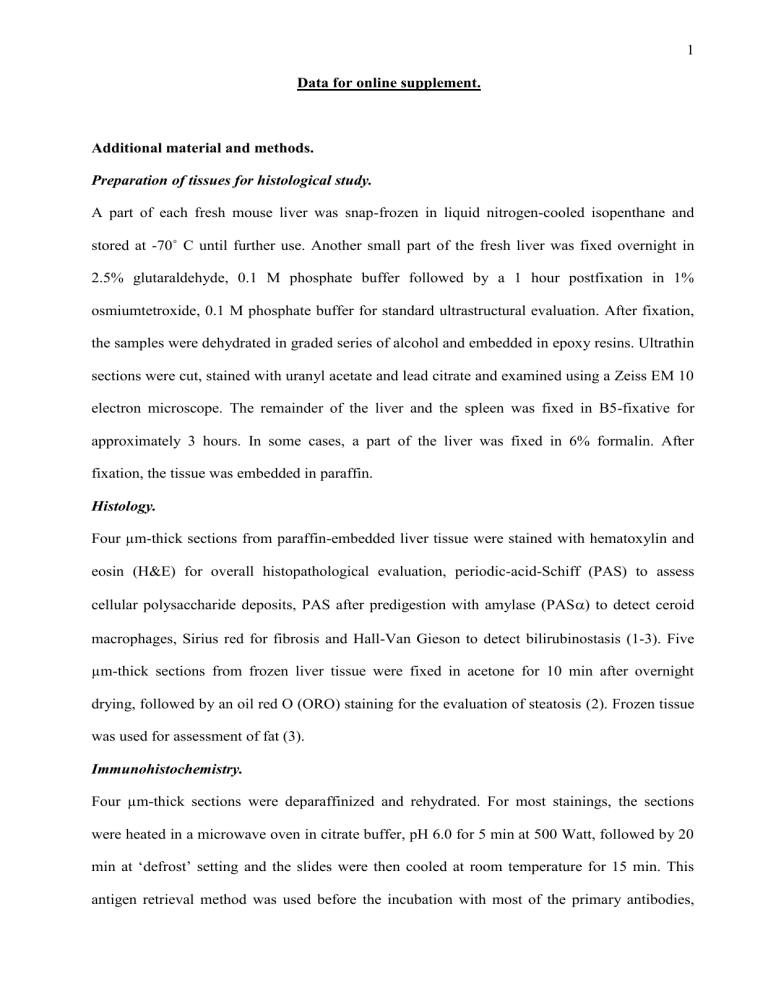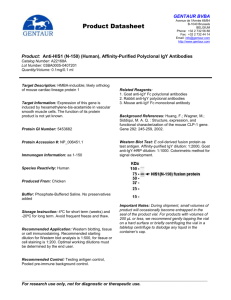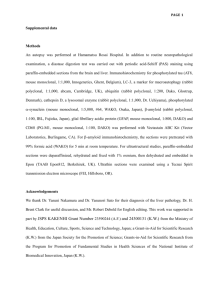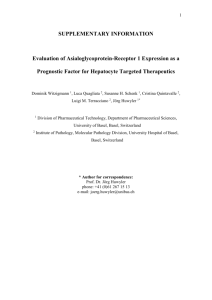jwsHEPv41.4.847

1
Data for online supplement.
Additional material and methods.
Preparation of tissues for histological study.
A part of each fresh mouse liver was snap-frozen in liquid nitrogen-cooled isopenthane and stored at -70˚ C until further use. Another small part of the fresh liver was fixed overnight in
2.5% glutaraldehyde, 0.1 M phosphate buffer followed by a 1 hour postfixation in 1% osmiumtetroxide, 0.1 M phosphate buffer for standard ultrastructural evaluation. After fixation, the samples were dehydrated in graded series of alcohol and embedded in epoxy resins. Ultrathin sections were cut, stained with uranyl acetate and lead citrate and examined using a Zeiss EM 10 electron microscope. The remainder of the liver and the spleen was fixed in B5-fixative for approximately 3 hours. In some cases, a part of the liver was fixed in 6% formalin. After fixation, the tissue was embedded in paraffin.
Histology.
Four µm-thick sections from paraffin-embedded liver tissue were stained with hematoxylin and eosin (H&E) for overall histopathological evaluation, periodic-acid-Schiff (PAS) to assess cellular polysaccharide deposits, PAS after predigestion with amylase (PAS
) to detect ceroid macrophages, Sirius red for fibrosis and Hall-Van Gieson to detect bilirubinostasis (1-3). Five
µm-thick sections from frozen liver tissue were fixed in acetone for 10 min after overnight drying, followed by an oil red O (ORO) staining for the evaluation of steatosis (2). Frozen tissue was used for assessment of fat (3).
Immunohistochemistry.
Four µm-thick sections were deparaffinized and rehydrated. For most stainings, the sections were heated in a microwave oven in citrate buffer, pH 6.0 for 5 min at 500 Watt, followed by 20 min at ‘defrost’ setting and the slides were then cooled at room temperature for 15 min. This antigen retrieval method was used before the incubation with most of the primary antibodies,
except for those against albumin, mitochondria, carcinoembryonic antigen (CEA) and hepatitis
2
B surface and core antigen (HBsAg and HBcAg), since we always obtain adequate staining without antigen retrieval when performing immunohistochemistry with these antibodies on routine clinical liver biopsies processed in an identical fashion as the samples in the present study.
Incubation with the primary antibodies was performed at room temperature for 30 min, followed by three washes with PBS. The different human cell types within the mouse livers were studied with a polyclonal rabbit anti-human antibody against albumin (dilution 1/200, Dako, Denmark) and monoclonal mouse anti-human antibodies against mitochondria (clone 113-1, dilution 1/100,
Chemicon, USA), pan-cytokeratin (clone KL1, dilution 1/50, Immunotech, USA), cytokeratin 8
(CK8) (clone 35betah11, dilution 1/100, Dako), CK18 (clone CD10, dilution 1/10, Dako), CK7
(clone OV-TL12/30, dilution 1/50, Dako), CK19 (clone RCK108, dilution 1/20, Dako), vimentin
(clone V9, dilution 1/30, Dako), and CD34 (clone My10, dilution 1/10, Becton Dickinson, USA) and Ki67 (clone Mib-1, dilution 1/100, Dako). Albumin is a well-established marker of hepatocytes while vimentin is a marker of all mesenchymal liver cells (i.e. (myo)fibroblasts, hepatic stellate cells and endothelial cells (4), while CD34 only stains endothelial cells (5). The different anti-keratin antibodies were used to detect all human epithelial cells. Their staining intensity and pattern and the morphology of the positive cells makes it possible to recognize mature hepatocytes, bile duct epithelial cells and cells of the progenitor cell compartment (i.e. hepatic progenitor cells, intermediate hepatocyte-like cell and reactive ductular cells) (6). The monoclonal mouse anti-human antibody Ki67 (clone Mib-1, dilution 1/100, Dako) was used to assess the proliferative status of human hepatocytes, since it stains all nuclei that are not in the
G0-phase (7). Expression of viral proteins was assessed using a polyclonal rabbit antibody against HBcAg (dilution 1/200, Dako) and monoclonal mouse antibodies against HBsAg (clone
H1, dilution 1/80, ForLab, Belgium) and HCV E2 (clone IG222, 1/50, Innogenetics, Belgium).
Immunohistochemical analysis of liver tissue with the antibody IG222 is a specific and sensitive
method to detect HCV infection (8). To evaluate both human and mouse cells, polyclonal rabbit
3 anti-human antibodies against CEA (dilution 1/300, Dako) were used. The polyclonal antibody against carcinoembryonic antigen (pCEA) is a marker for canaliculi (9). For all mouse monoclonal antibodies, the secondary antibody was undiluted anti-mouse Envision (Dako). The secondary antibody was applied for 30 min, followed by a wash in three changes of phosphatebuffered saline (PBS) for 5 min. A second step was not used for the anti-albumin antibody, since this antibody is peroxidase-labeled while the others are unlabeled. For the rabbit polyclonal antibodies against CEA and HBcAg, the second and third step consisted of swine anti-rabbit immunoglobulins and rabbit peroxidase-antiperoxidase (both from Dako) diluted in phosphatebuffered saline (PBS), pH 7.2, containing 10% normal human serum. The incubations were carried out for 30 min at room temperature and each incubation step was followed by a wash in three changes of PBS for 5 min. For all stainings, the brown reaction product was developed with the use of 3,3-diaminobenzidine tetrahydrochloride and H
2
O
2
. The sections were counterstained with hematoxylin.
Sections wherein the incubation with the first and/or secondary/tertiary antibodies were omitted and fully-processed sections of liver tissue from untransplanted animals served as controls.
Positive controls consisted of selected liver biopsies from the clinical routine that were stained with these antibodies.
Quantitative assessment of the different human liver cell types present in uPA-SCID liver.
To measure the fraction of liver parenchyma represented by human hepatocytes, digital pictures
(totally 7 to 8 pictures per liver) were taken with a 5x objective. Using Adobe Photoshop 7.0, the amount of pixels within the total liver parenchyma (excluding large portal veins, areas of calcifications, red foci and areas without tissue) was determined and compared to the amount of pixels within delineated human hepatocyte areas. To quantify proliferating hepatocytes the number of Ki67 nuclei positive hepatocytes was counted in random fields of at least 300 human hepatocytes.
4
References.
1. Luna L. Manual of histologic staining methods of the Armed Forces Institute of
Pathology. 3 edition ed. New York: McGraw-Hill Book Company, 1968.
2. Bancroft J, Cook H. Manual of histological techniques. Edinburgh: Churchill
Livingstone, 1984.
3. MacSween R: Morphological diagnostic procedure: liver biopsy, fine needle aspiration biopsy. In: MacSween R, Burt A, Portmann B, Ishak K, Scheuer PJ, Antony P, eds. Pathology of the liver. Edinburgh: Churchill Livingstone, 2002.
4. Ellis I: Immunocytochemistry in diagnostic pathology. In: Bancroft J, Stevens A, eds.
Theory and practice of histological techniques. Edinburgh: Churchill Livingstone, 1996; 471-
489.
5. Fina L, Molgaard HV, Robertson D, Bradley NJ, Monaghan P, Delia D, Sutherland DR, et al. Expression of the CD34 gene in vascular endothelial cells. Blood 1990;75:2417-2426.
6. Libbrecht L, Roskams T. Hepatic progenitor cells in human liver diseases. Semin Cell
Dev Biol 2002;13:389-396.
7. Gerdes J, Schwab U, Lemke H, Stein H. Production of a mouse monoclonal antibody reactive with a human nuclear antigen associated with cell proliferation. Int J Cancer
1983;31:13-20.
8. Verslype C, Nevens F, Sinelli N, Clarysse C, Pirenne J, Depla E, Maertens G, et al.
Hepatic immunohistochemical staining with a monoclonal antibody against HCV-E2 to evaluate antiviral therapy and reinfection of liver grafts in hepatitis C viral infection. J Hepatol
2003;38:208-214.
9. Lau SK, Prakash S, Geller SA, Alsabeh R. Comparative immunohistochemical profile of hepatocellular carcinoma, cholangiocarcinoma, and metastatic adenocarcinoma. Hum Pathol
2002;33:1175-1181.






